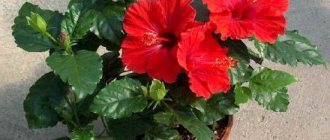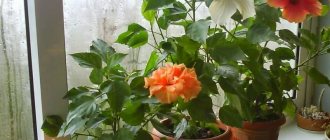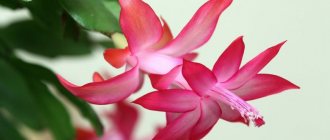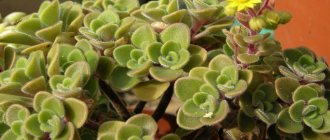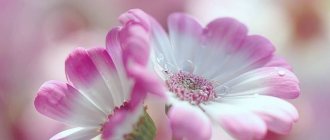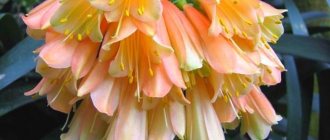General features of the Chinese rose
The Chinese rose plant is considered a tree-like shrub and, when cared for indoors, grows approximately 2 m in height. The plant blooms with large single flowers, which can be red, white, orange and other colors.
As a rule, each flower pleases for 1-2 days, then gradually dries out, but with proper care, the total flowering period can be from early spring to late autumn.
This plant is divided into more than 500 varieties, each of them is beautiful in its own way and has certain care requirements, so the description of the flower may vary. There are varieties that are considered not only decorative, but can also be used in cosmetology, medicine, products...
The most suitable varieties for tree formation
Rose Polka - features of a popular flower
All varieties of plants can be grown on a trunk. Below are the names of roses that are as spectacular as a tree. But they can also be grown as a bush.
Princesse de Monaco
Hybrid tea variety. The bud has the shape of a glass, white with a pink coating, with a diameter of up to 14 cm. The hybrid has good resistance to disease and frost. It blooms throughout the summer, the fallen flowers are replaced by many new ones. The variety has won a number of international awards in the field of rose growing. Suitable for decorating small gardens.
Jardins de Bagatelle
An erect bush with single flowers on stems. The buds have a half-opened appearance, the color is beige-pink, the petals are curled. The hybrid has a pronounced aroma when flowering. The species is winter-hardy, so in the northern regions it can be grown in open ground.
Marcel Pagnol (Marcel Pagnol)
The cone-shaped dark red flowers of the plant are ideal for cutting and have an intoxicating aroma. Marcel Pagnol is one of the most popular varieties in the world. The height of the shoots can reach 1.5 m, and the size of the bud is 12 cm. The petals are velvety, with a slightly wavy edge. The bush is distinguished by abundant repeated flowering; the flower has the shape of a bowl.
Rose variety Marcel Pagnol
Catherine Deneuve
The flower is valued for the rare color of its petals – orange-salmon. The bud opens up to 12 cm in diameter. On moist, fertilized soils, the rose blooms profusely. The bush is resistant to powdery mildew and pests.
Nuances in caring for hibiscus
Caring for the Chinese rose at home should be clear, systematic and, of course, correct, only in this case the plant will be healthy and evergreen, and will delight with flowering for many years. For healthy growth, the Chinese rose needs:
- Correct location with optimal temperature and humidity.
- Timely watering and fertilizing.
- Regular pruning and replanting of the plant according to the norms of its age.
- Quite a large amount of space and good soil.
If you adhere to all these points, then the Chinese rose will not get sick, but will grow healthy and, accordingly, bloom and decorate the interior.
LiveInternetLiveInternet
With its bright colors and its beauty, blooming hibiscus attracts the attention of many gardeners who willingly grow it at home. This article will tell you how to care for hibiscus at home.
Chinese rose or hibiscus is a very popular indoor plant, which today even novice gardeners readily grow. This flower can be found in an apartment or private house in the Moscow region and in other regions of our country. This plant is native to Southeast Asia. Judging by the name, its homeland is China. Although for some species of hibiscus the homeland is in America, Africa and the Pacific Islands. In some countries it is called the flower of death.
Indoor hibiscus has a different description because this flower is characterized by a large number of varieties that differ from each other in the following parameters:
Despite such a variety of varieties, you can often find Chinese hibiscus in apartments and private houses. This flower grows wild in northern Indochina and southern China. In countries where the climate does not allow hibiscus to be grown in gardens, it is planted in greenhouses or flower pots. In addition to the Chinese rose, you can often find hibiscus in the same pot in an apartment. It is also very popular for growing at home (in an apartment or private house).
The Chinese rose belongs to the Hibiscus genus and the Malvaceae family. Different varieties have different descriptions. For example, some varieties look like a tree, while others look like a bush. The Chinese rose is an evergreen tree or shrub. If the hibiscus care was correct, then the Chinese rose can reach three meters in height. But such dimensions can only be obtained if the shrub grows in a greenhouse. At home, hibiscus (its different varieties) can grow to a maximum of two meters. Chinese rose can be grown in an apartment in one pot, planting several plants in it at once. Sometimes you can find a description of this indoor flower as a standard tree.
Chinese rose is a shrub that has leaves that resemble birch leaves. They are dark green, smooth and shiny. There are teeth on the edge of the leaf blade. The leaf shape itself is elongated-oval. Indeed, this description is very similar to birch leaves
.
The shrub produces single flowers. On one bush they can be scattered throughout the plant. Initially, the flowers look like narrow buds, which open and become like fairly wide cups. Their diameter can vary from 8 to 14 cm. Flowers can be double or simple. Their description and color of the buds depend on the variety.
Interestingly, each flower blooms for only one or two days. Proper plant care will help you achieve constant flowering. Moreover, in some countries the color of this plant is a harbinger of death. But don’t worry if the Chinese rose blooms on time. After all, death is indicated by a color that appeared at an uncharacteristic time. Normally, indoor hibiscus blooms from early spring until late autumn. It is in spring that the plant wakes up after winter and is ready to enter the active stage of development - flowering. But when a color appears at an uncharacteristic time, you need to look for the root cause, and not believe ancient superstitions.
It is worth noting that in some countries this flower (young shoots) is eaten as a salad ingredient. Therefore, this plant in such countries is often grown in one pot, many of them. Chinese rose flowers are also used to make hair dye.
Such an interesting plant as indoor hibiscus can be found in our homes in the Moscow region and in other regions of the country. At the same time, many flower growers do not even think about the possibilities of using it for purposes other than decorating a window sill.
The Chinese rose will be an excellent indoor plant in the house, as caring for it is quite simple. Even an inexperienced gardener can handle it. The main condition that is worth remembering when you intend to grow indoor hibiscus in your home is the correctly selected place for its growth. But you still can’t do it without proper care. You need to keep a Chinese rose in the house in the summer at a temperature of +20-25 degrees. At the same time, in winter it is necessary to keep the flower in the temperature range of +14-16 degrees, but lowering the temperature below +12 degrees is not recommended. At this temperature, hibiscus in the spring at the specified time, even when growing several plants in one pot, will give a beautiful color.
You need to care for your hibiscus in such a way that there is no dry air in the room. Plants, especially those grown in one pot, react quite negatively to dry air (for example, their color falls off). Very often the formed buds do not even have time to open. To avoid this, the bush should be sprayed periodically, but watering should not be done more often. Remember that water should not get on the color of the plant.
In summer, the flower pot can be kept in the fresh air. But here you should know that the bush should not be exposed to direct rays of the sun. Wind and rain will also be detrimental to the plant in such a situation.
An important parameter for choosing a place to grow Chinese roses in the Moscow region or any other region of the country is lighting. This plant, grown in a single pot or vase, loves indirect but bright light. Such lighting can be created by placing, for example, a pot on the windowsill. In this case, drafts must be avoided. Because of it, the color of the plant may also suffer. Lack of lighting will result in the bush not blooming or the buds remaining unopened. Therefore, in order to get a beautiful and blooming flower, you need to keep it in a well-lit place where it is not exposed to direct sunlight.
You also need to periodically add fertilizer to the pot. Feeding is carried out for a plant growing in one pot. So it is also needed when growing a flower together with other plants in the same pot. Fertilizing should be carried out during flowering and bud formation. In winter, when the flower is in the dormant stage, no fertilizer is applied.
When it is time to apply fertilizer, it can be purchased at a flower shop. We select fertilizers specifically for Chinese roses. In summer, fertilizing is applied to flowering plants once every two weeks. During the period of active growth of hibiscus (spring-autumn), fertilizer is applied every week. It is recommended to alternately apply mineral and organic fertilizers.
Any indoor flower, including hibiscus, needs to be cared for properly. Moreover, the most important aspect of care will be properly organized watering. Chinese rose loves moisture. Therefore, in the warm season, watering should be generous. It is also recommended to spray the bushes. Watering is carried out only with settled soft water at room temperature. If several flowers grow in one pot, then watering them should cover the moisture needs of all plants.
In winter, watering is reduced and carried out only when adding the top layer of soil. At this time, the plant reacts very strongly to flooding or severe drying of the soil.
As you can see, watering Chinese roses does not cause any difficulties. Therefore, anyone can keep such a flower in their home.
Caring for hibiscus requires more than just proper watering and fertilization. Periodically it is necessary to prune and pinch the bush. Pruning can be done while transplanting the flower into a new pot. It is necessary to pinch and trim this plant for the following purposes:
- stimulating shoot growth;
- acceleration of flowering;
- the formation of a lush and decorative crown of shrubs growing in one pot;
- removing dry shoots from the bush. In this case, healthy shoots can be cut in half.
To avoid infection during pruning, the sections are treated with garden varnish. In this case, healthy cuttings obtained during pruning can be planted in a separate pot. This planting will allow you to propagate Chinese roses at home.
The sample is carried out when the time has come to transplant the plant into a new pot. Before carrying out this manipulation, trimming is done. If you prune in summer, flower buds will form on regrown branches in early autumn. Thus, you can enjoy the blooming of Chinese roses right up until spring.
By pinching, you can form almost any crown. You need to pinch the tops of the shoots.
An important point in caring for indoor hibiscus is its planting and replanting. Plants are always planted in a new, slightly larger pot. A very spacious pot will cause the flower to stop blooming. Therefore, many gardeners recommend choosing a narrow container for planting Chinese roses. If an adult shrub is planted, then only a partial replacement of the top layer of soil is done. Moreover, their transplantation is carried out once every 3-4 years. But young plants can be replanted every year.
When planting and replanting, it is necessary to choose the right soil for the plant. The soil for this hibiscus variety should consist of the following components:
These components should be added in proportions of 1:2:1, respectively. You can also add sand and bone meal to this mixture.
Planting and replanting Chinese roses is carried out only in pots, at the bottom of which a drainage layer has been formed. To create it, you can use clay shards. Without it, the roots of the shrub may rot, even if it is kept in optimal growing conditions.
By growing a Chinese rose at home, you can propagate the plant and create an entire home garden. This flower reproduces well in the following ways:
- seeds;
- cuttings that can be obtained through formative pruning. For these purposes, only healthy cuttings should be used. Rooting of cuttings occurs in about 3-4 weeks.
If the hibiscus at home has not been properly cared for, the plant will begin to get sick or pests will appear on it. Signs of the disease are the following symptoms:
Very often, Chinese roses at home suffer from chlorosis. To get rid of this sore, it is necessary to normalize proper watering and nutrition of the flower.
Among the pests on hibiscus, due to violation of the rules of care, aphids and spider mites are often found. When they appear on the bush, you can notice a cobweb. To control pests, the plant should be treated with a soap solution, and in advanced situations - with insecticides.
If you do not start treating a diseased flower in time, you may soon lose it completely. Therefore, it is recommended to adhere to proper plant care and periodically check the bush for the appearance of insect pests.
Following the care rules given in this article will help you grow a beautifully blooming and tall Chinese rose bush at home, which will delight you with its health and excellent decorative appearance.
Requirements for the location of hibiscus
It is best to place the hibiscus in a place where there is a lot of diffused light. It is worth noting that it is better to protect the indoor plant from direct warm sunlight so that the leaves do not get burned.
Hibiscus absolutely cannot tolerate the slightest drafts, so even during the period of airing the room, it is better to take the flower to another room. The optimal air temperature is considered to be +18-25 degrees Celsius in the summer, and in the winter the minimum temperature is +15 degrees Celsius.
This plant feels comfortable at high air humidity. It is necessary to systematically spray the plant, but do not allow water to get on the flowers, because they may become stained or wither faster.
How to water and fertilize a Chinese rose
Since the Chinese rose indoor flower grows very well in a room with high air humidity, watering is required abundantly, but not too often.
Before watering the flower, it is advisable to stand the water and wait for the top layer of soil to dry. In autumn and winter, the amount of watering is slightly reduced; the water should always be at room temperature.
Chinese rose must be fed and fertilized with mineral complexes. Experts recommend applying fertilizer 2 times a month from April to September.
It is best to use liquid fertilizers that contain iron, copper, and nitrogen. In winter, fertilizing is necessary only at the time of flowering; the fertilizer must contain phosphorus and potassium.
Before you start treating the plant with fertilizers, you need to water it well. Florists also advise feeding the flower in the evening.
Trimming
As a rule, pruning of indoor crops is done after flowering. As additional work on the formation of the bush, you can perform pruning in the spring; also during this period you need to trim off dried shoots, if any.
In order for the rose to grow and develop properly, after cutting the branches, at least 5 buds must remain on each shoot. The rest must be separated from the bush. To properly trim an elongated bush, you need to follow the same rules, otherwise the flower will not bloom, since the plant will direct all its energy into growing shoots.
It is also necessary to prune faded roses, which can still be nourished by the juices of the crop, in addition, they will spoil the appearance of the plant.
When to prune and replant hibiscus
Hibiscus requires timely pruning and replanting, namely, after the plant has flowered, it is worth cutting off all the shoots. With the onset of spring, it is best to pin down all shoots.
When shoots grow inside the bush or parallel to the base of the plant, they also need to be pruned. As a rule, such an ornamental plant tolerates pruning well at any time of the year.
Until the plant is 5 years old, it needs to be replanted once a year, then it will be enough to replant it once every 3-4 years. The most optimal soil for growing hibiscus is a mixture that includes sand, leaf and humus soil.
If the plant is still young, it is advisable to add peat soil. The right time to transplant Chinese roses is spring.
Action plan for replanting hibiscus:
- Sterilize the flower pot.
- Prepare the soil.
- Remove the plant from the pot directly with the soil, just shake it slightly.
- If there are rotten roots, they need to be removed.
- Place the plant in a new flower pot in the center and sprinkle with soil, shake from time to time and lightly compact the layer.
- Water and spray the plant generously.
- Place the plant in its original place.
It is worth noting that after transplantation the plant cannot be moved to a new location.
Flower breeding
It is possible to grow a rose on a trunk yourself, but to do this you need to have enviable patience and professional skill in performing grafting.
Growing a rootstock on a trunk takes four years, while rose hips can be grown from seed or cuttings. Most often, strong shoots are separated from a rose hip bush and transplanted to certain places so that it can grow.
The use of rose hips for this purpose yields only forty percent of the required seedlings. During the growth of the rootstock, it is necessary to carry out a high-quality selection of seedlings for further grafting. In the third season of rosehip growth - in the fall - all shoots at the level of the root neck are removed from the bush, except for the central one.
The grafting is done at the same time as with conventional roses, grafting two buds at the top of the shoot. During winter, the trunks are protected from the cold by bending them as low as possible to the ground. With the onset of heat, the buds begin to develop on the shoot. During the summer season, the plant is given shape, achieving tillering of the crown.
Methods for propagating hibiscus
As a rule, hibiscus is propagated in several ways:
- using seeds is the best option for sowing in winter. First, the seeds of the Chinese rose must be well soaked in the solution. A plant grown using this method begins to bloom after 2-3 years;
- through cuttings - the simplest and easiest way to grow this plant and begins to bloom after 1 year. It is best to plant hibiscus using this method in the autumn month.
Shelter for the winter
They begin to cover standard roses in late October - early November, before the onset of persistent cold weather. The crown is pre-pruned in accordance with the variety’s belonging to the garden group, but all immature shoots are completely removed. In hybrid tea roses and roses of the floribunda group, the shoots can be shortened to a height of 30–40 cm. If the standard rose is cascading, longer shoots are left; for climbing small-flowered roses - all shoots for the entire length, shortening them slightly. However, in any case, all leaves are cut off - it is not advisable to leave them, because Over the winter they rot and become a source of fungal diseases.
The trunk is dug up with a shovel and bent to the ground, spruce branches are placed under the crown of the trunk, and another layer of spruce branches is placed on top, secured with film or lutrasil. The root and base of the trunk are covered with dry earth (in some cases, the crown with spruce branches can be covered with earth). Subsequently, the fallen snow finally covers the plants and serves as a warm blanket for them.
The shelter should be completely removed in the spring only after the snow has melted and the danger of severe frost has passed - usually this happens after April 10. But later opening leads to damping off and death of plants.
Problems and diseases of hibiscus
The photo of the Chinese rose attracts attention with its lush green leaves and large colorful flowers. But if not properly cared for, this plant can get sick and lose all its attractive features.
The most common diseases and problems of hibiscus:
- buds falling off - occurs due to insufficient watering, low air temperature;
- leaves dry and curl up - very dry air;
- the appearance of yellow leaves - occurs when watering with poor water or at low air temperatures;
- there are pink spots on the leaves - due to insufficient light or excess fertilizer.
Pests often include aphids, spider mites or scale insects.
Description
The Chinese rose naturally reaches a height of 2 - 2.5 meters. The leaf of the plant is smooth, arranged alternately on the branches, has a dark green color, and has teeth along the edges. A sticky substance secreted by the plant regularly appears on the leaves; therefore, in order to provide complete care for the plant, this juice must be washed off. Hibiscus flowers have the greatest decorative value. They look like bells and reach a diameter of 10-12 cm, which is considered quite large. The petals have a variety of shades.
